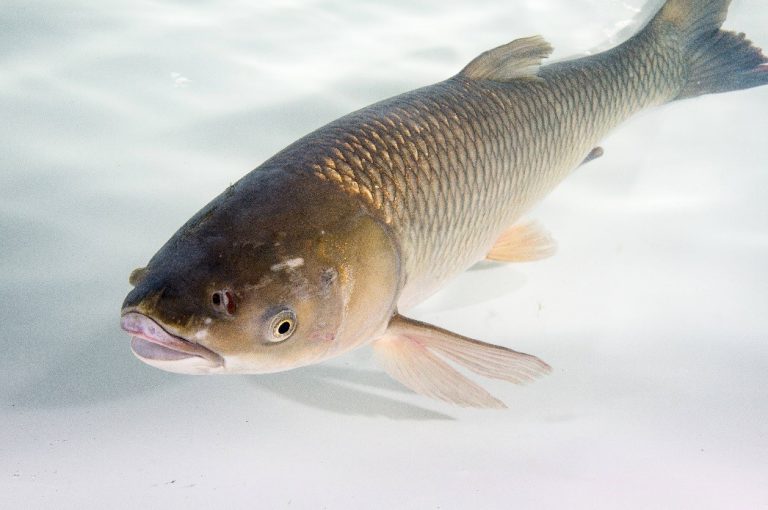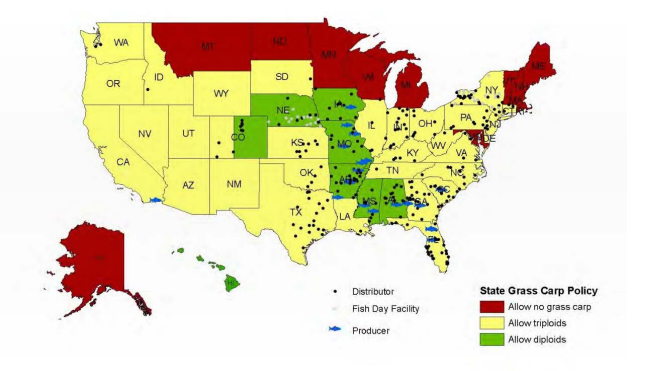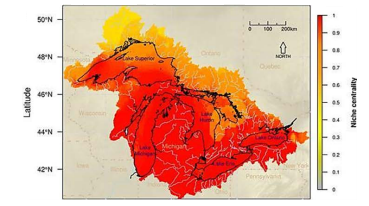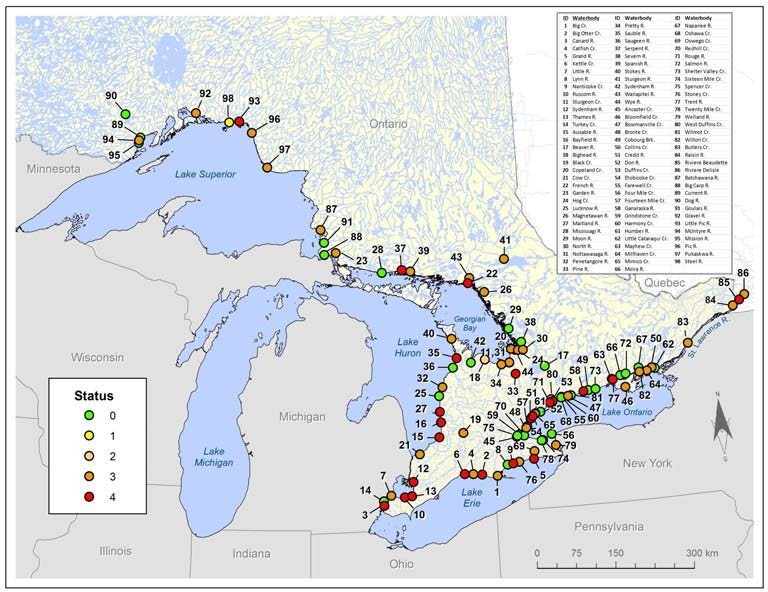In 2016-17, Fisheries and Oceans Canada led the development of a Binational Ecological Risk Assessment of Grass Carp for the Great Lakes Basin to determine the extent of the risk of Grass Carp and to provide useful, scientifically defensible advice on prevention, monitoring, early detection, and potential management actions for managers and decision-makers in Canada and the United States. This risk assessment covered both triploid (sterile) and diploid (fertile) Grass Carp. It assessed the probability of occurrence (likelihood of arrival, survival, and spread) for triploid Grass Carp, and the probability of introduction (likelihood of arrival, survival, establishment and spread) for diploid Grass Carp, as well as the potential magnitude of ecological consequences. This webpage summarizes the results of the risk assessment. Read the full Ecological Risk Assessment of Grass Carp and the Update to the Ecological Risk Assessment of Grass Carp.

Grass Carp (Ctenopharyngodon Idella) is a sub-tropical to temperate species native to the large rivers of eastern Asia. Grass Carp consume aquatic vegetation, but will also consume filamentous algae and other aquatic and terrestrial macrophytes, invertebrates, and small fishes. Grass Carp was originally brought to North America in 1963 through a joint initiative of the United Nations Food and Agriculture Organization, the USFWS, and Auburn University for biological control of aquatic vegetation. These fish successfully spawned and some offspring are thought to have escaped from experimental enclosures.
Arrival
Grass Carp have arrived in lakes Michigan, Erie and Ontario. Arrival for a given lake was considered to be the repeated detection of at least one Grass Carp in at least one part of the lake basin within any continuous five-year period.
Three vectors of potential entry into the Great Lakes basin were identified and assessed: physical connections, human-mediated release, and laker ballast. For Lake Erie, it is still unclear if the arrival of diploid Grass Carp occurred through the vectors and pathways considered in arrival, or if it occurred through spread from another Great Lake. Possession, importation, propagation, stocking, sale and transportation of Grass Carp, diploid or triploid, is prohibited in Michigan, Minnesota, Ontario, or Wisconsin. Only triploid Grass Carp are allowed in Illinois, Indiana, Ohio, New York, and Pennsylvania. Possession of diploid Grass Carp are permitted in Iowa and Missouri, which each border at least one Great Lakes state (see Figure 1). Regulations and their effective enforcement are important factors that may affect the likelihood of arrival.

| Superior | Michigan | Huron | Erie | Ontario |
Diploid Arrival | Low | Very Likely | Low | Medium | Low |
Triploid Arrival | Low | Very Likely | Low | Very Likely | Low |
Table 1. Overall likelihood of arrival for each lake for diploid and triploid Grass Carp 50 years from the baseline (i.e., 2014). Overall arrival is the combination of physical connections, laker ballast and overall human-mediated release.
Survival
Survival is defined as the ability of individuals to arrive and not die upon arrival, and for adults to survive the winter months. The biological requirements considered included thermal tolerance, food resources, potential predation pressure, and disease occurrence.
Grass Carp have a broad thermal tolerance. To date, adult Grass Carp have been captured in all of the Great Lakes except Lake Superior. Based on otolith microchemistry, it is known that fish captured from the Lake Erie and Lake Michigan basins have survived and overwintered in at least the southern portion of these basins. Survival at northern latitudes of Lake Superior is less certain based on some climate-based models.

Enough food and habitat exist throughout the four lower Great Lakes for Grass Carp to survive and overwinter.
Grass Carp are unlikely to be susceptible to most predators for very long, relative to lifespan, given their rapid growth rates. Predation on adult Grass Carp in the Great Lakes would most likely come from humans (e.g., recreational capture) and large predatory birds because adult Grass Carp are unlikely to be susceptible to predation by piscivorous fishes in the Great Lakes.
Grass Carp may be susceptible to certain diseases in the Great Lakes; however, it is unlikely that these diseases will have a large impact on survival.
| Superior | Michigan | Huron | Erie | Ontario |
Diploid Survival | High | Very Likely | Very Likely | Very Likely | Very Likely |
Triploid Survival | High | Very Likely | Very Likely | Very Likely | Very Likely |
Table 2. Likelihood of survival rankings for triploid, and diploid Grass Carp, 50 years from the risk assessment baseline (i.e., 2014). Survival is defined as individuals do not die upon arrival and adults live through winter months in the Great Lakes basin.
Establishment
Assessment of the likelihood of establishment is based on the presence of a self-sustaining population, which is defined as occurring when individuals spawned within the Great Lakes basin, have subsequently successfully reproduced.
The establishment of Grass Carp in the Great Lakes is dependent upon availability of suitable spawning and nursery habitats, enough individuals for positive population growth, stock size required for effective recruitment, and survival of early life stages.
In the Great Lakes, the assessment determined that:
- Suitable spawning conditions exist in up to 57 rivers in the Great Lakes basin.
- Extensive wetlands exist which would provide suitable habitat and food for a population.
- Very few adult males and females are required for a >50% chance of annual successful spawning
| Superior | Michigan | Huron | Erie | Ontario |
Diploid Establishment | Low | Very Likely | Very Likely | Very Likely | Very Likely |
Triploid Establishment | Very Unlikely | Very Unlikely | Very Unlikely | Very Unlikely | Very Unlikely |
Table 3. Likelihood of establishment rankings for each lake for triploid, and diploid Grass Carp, 50 years from the risk assessment baseline (i.e., 2014). Establishment is assessed independently of other elements in the introduction process and is evident by a self-sustaining population which is defined as the occurrence of individuals spawned within the Great Lakes basin subsequently reproducing.
Spread
Following the introduction into a single lake, Grass Carp would be expected to spread to other lakes within 10 years. Spread would be more rapid for lakes Erie, Huron, Michigan and Ontario; longer for Lake Superior.

| Superior | Michigan | Huron | Erie | Ontario |
Diploid Spread | Low | Low | Very Likely | Medium | Low |
Triploid Spread | Very Unlikely | Very Unlikely | High | Very Unlikely | Low |
Table 4. Likelihood of spread (between lakes, e.g., into Lake Superior from other lakes) for each lake for triploid, and diploid Grass Carp, 50 years from the risk assessment baseline (i.e., 2014). Spread is defined as the movement of individuals or expanding populations into new areas within the basin, between lakes; but not into the basin, as this is arrival.
Ecological Consequences
Grass Carp is an herbivorous fish that consumes large quantities of aquatic plants. Just 10 adult Grass Carp per hectare can reduce wetland vegetation by up to 50%. When more than 15 fish per hectare are present, wetland vegetation can be reduced by more than 50%. High impacts are predicted for 33 fish species and 18 bird species in the Great Lakes as a result of reduced vegetation and wetland habitat.
Grass Carp pose significant ecological threats to the Great Lakes through aggressive feeding and removal of aquatic vegetation, resulting in habitat loss and degradation affecting wetland fish and bird species.
Overall Risk
If no additional actions are taken, the overall ecological risk of Grass Carp to the Great Lakes is high, especially to the central lakes, with impacts of Grass Carp increasing over time. Impact of Grass Carp on the Great Lakes is directly related to establishment. Therefore, preventing establishment is critical.